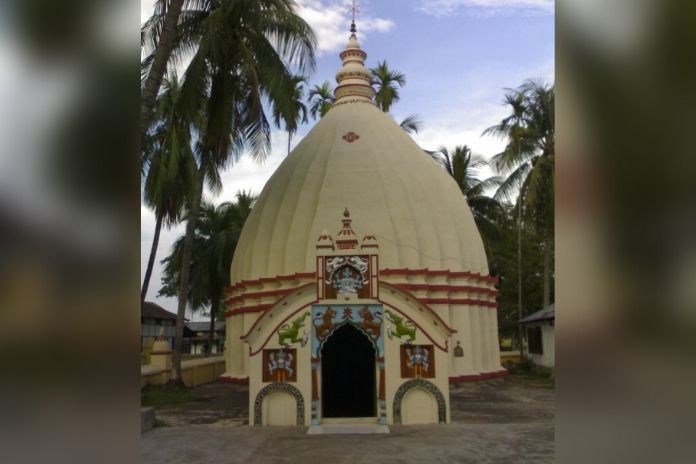Barvisnu Ata was one of the great apostles nominated by Mahapurush Sri Sri Madhabadeva. His contribution to the spreading of Ekasarana Nama Dharma propagated by Mahapurush Srimanta Sankaradeva was remarkable and unique among the galaxy of apostles of both the two Gurus.
His actual birth place cannot be exactly identified. However, Lakshminath Bezbaroa mentioned in his book ‘Sri Sri Sankaradeva and Sri Sri Madhabadeva’ – a place namely Bikrampur in the present day Bangladesh as his birth place. The Katha Guru Charita mentioned the names of his ancestors as follows:
Gouranga Mandal, his son Gourichandra, his son Sourivardha, his son Hirmal, his son Ahirmal, his son Virmal, his son Nirmal and his son Kangsari.
One day, Kangsari arranged a tour by boat to visit Assam along with his 120 friends. But then, as ill luck would have it, they faced a severe storm in the river. During that extreme situation, all of their belongings were either lost or damaged by the storm. Kangsari somehow managed to survive. He then proceeded to a nearby village for shelter and finally arrived at Malancha village. He settled there in the company of some kind-hearted people. But bagging was his livelihood. In the course of his begging, one day, he arrived in the courtyard of a rich family. Chandra Bhuyan, the owner of that family, was deeply attracted to see Kangsari and allowed him to settle in a newly constructed hut within his complex. Kangsari made an amicable relationship with the family members of Chandra Bhuyan. In due course of time, he settled there permanently. Chandra Bhuyan had three daughters of his own, the elder and the younger were already married off, except for the middle daughter Chandravati, who remained unmarried. Chandra Bhuyan expressed his willingness to marry off his daughter Chandravati to Kangsari, who happily agreed to the proposal. After their marriage, the couple remained there.
After a gap of two years, the couple was blessed with a boy, and the newly born was used to be called Gopal. But due to some unexpected events at that time, Kangsari and Chandravati left their parents’ abode and settled at the residence of their maternal uncle Sanai Bhuyan.
Spending their days in a different household and a new setting, they developed many experiences. However, they longed to have a house of their own. Thereafter, Kangsari built a house in a plot of land with the kind assistance of villagers. Chandravati gave birth to their second and third son Yodumoni and Haricharan respectively. Kangsari used to engage himself as a cultivator. He was also allotted necessary land for cultivation. The farmers namely Lapaniya, Banganbir and Adhabya also joined him. They are almost altogether engaged in cultivation and made sufficient grains.
One day, Kangsari and his farmer friends came to the north bank of the Brahmaputra in search of rice plant for seedlings. In the course of their quest for rice plant, they arrived at the residence of Narayana Das Thakur Ata, who was at that time dwelling in a village called Manthai. When they arrived at his residence, Thakur Ata was out somewhere, however they were well received and treated by his wife – Varabasi. At night, Kangsari recited some padas composed by some unknown bard. Next morning, Narayan Das received Kangsari with a smiling face, and after welcoming him, wanted to know the name of the person who recited the padas. Kangsari let him know that he himself recited the same. Narayana Das again asked him – “Do you know the name of the scripture which contain padas and the name of the composer?” Kangsari replied that the scripture, so far he knew, was called Bhakti Pradip, however, the name of the composer was unknown to him. Thakur Ata then said to Kangsari in a smiling face – “How strange! You do not know the name of rice which you have been habituated to take regularly?” Kangsari was embarrassed by his words, and very politely asked him to let him know the name of the bard who composed Bhakti Pradip. Narayan Das happily told him that Mahapurush Srimanta Sankaradeva was credited as the composer of the sacred scripture. But Srimanta Sankaradeva left this world for heavenly abode nominating Mahapurush Madhabadeva as the immediate successor of his religious domain. Both are two sides of the same coin. The later, of late, has been residing in the Sundaridiya Satra. This paved the way for Kangsari to meet Madhabadeva at the Sundaridiya Satra. And, ultimately, he got initiated into the sect of Madhabadeva. An amazing incident happened when Madhabadeva sighted Kangsari for the very first time. The name Visnu was suddenly pronounced by Madhabadeva, and so his name was replaced by Visnu. Since that auspicious moment, Kangsari became well acquainted with the name – Barvisnu Ata among the galaxy of devotees.
After his initiation, Barvisnu Ata remained with his guru Madhabadeva at Sundaridiya. After spending a few productive days, he returned home to his family. His son Gopal and wife Chandravati were happy to see him. Barvisnu asked his son and wife to get initiation into the religious domain of Sankaradeva. They eagerly did so and became stern followers of nam dharma. Barvisnu Ata was very much happy to discern their devotion to Guru Sankaradeva and Madhabadeva, which he did expected from them.
One day, Barvisnu Ata organised a small gathering. He invited the leading personalities of the locality. During that meeting, he proposed to build a Satra at Malancha. All the attendees were satisfied to the proposal of Barvisnu Ata. Ultimately, a Satra was constructed for the villagers, which was called Malancha Satra. The erecting of the Satra at Malancha was a torch-bearer to the locality. Barvisnu was praised by everyone in the village community for nurturing ethnic integration and causing the spiritual upliftment of the Satra; he also arranged necessary training and workshop in order to educate the people in the art of performing nam prasanga, singing Borgeet, playing khol, taal, etc, in a proper way. Thus, Barvisnu Ata became a true and stern follower of Sankaradeva and Madhabadeva and eka sarana nam dharma. For his noble virtues and ardent devotion to religion and spirituality, people from all over the south bank (known as Dakhinkul) used to visit Malancha Satra, and in due course of time, all of them got initiation into the religious doctrine of eka sarana nam dharma. Thus the glory, name and fame of the Malancha Satra and Barvisnu Ata started spreading throughout the north and in the south bank also.
The days passed by with great joy, but the Satra faced a crisis. The crisis that was faced by the Satra came from the Brahmaputra. It seemed that the erosion caused by the river was going to swallow the Satra complex in the days to come. So, Barvisnu Ata turned his attention to a much safer place located nearby. It was a place full of natural beauty. He rebuilt the Satra at that place and used to call it ‘Samariya Satra’. The newly built Samariya Satra developed day by day and became a seat of learning, practising and propagation of eka sarana nam dharma, art and culture connected with the Mahapurushia tradition.
Article By
- Gouravjyoti Pathak
- (gjpathak20042007@googlemail.com)
(A prominent socio-cultural activist and philanthropist, Gaurav Jyoti Pathak is actively involved in promoting and preserving Sattriya art, culture and literature.)





